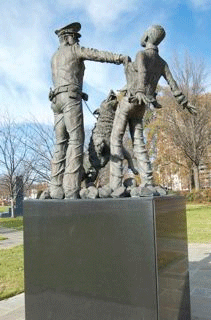
We awoke this morning knowing that today would be a tough day – we were heading to the Sixteenth Avenue Baptist Church, where a Klan bomb killed four young girls in 1963. We went first to the Birmingham Civil Rights Institute, which powerfully describes life in Jim Crow Birmingham. The museum has a particular focus on “Project C” (C is for Confrontation) in Birmingham, and features such items as the bars from the jail cell where Dr. King wrote “Letter from the Birmingham Jail” and the tank in which Bull Connor, Birmingham’s police chief, rode through town.
Across the street is Kelly Ingram Park, where policemen turned dogs and firemen turned firehoses on the hundreds of children who were gathering to march. The park houses monuments that commerate that struggle in an unusually frank manner – statues of lunging dogs, firehoses, and children in jail suggest the violence that marked Birmingham during this period.

Finally, we headed to the church. Our guide was Carolyn McKinstry, who was 14 and a friend of the four girls who were killed in the bombing. Ms. McKinstry answered the church phone that morning and heard a voice say “Three minutes.” A child herself, she had no idea what that meant, and one minute later dynamite exploded. Ms. McKinstry described the day and her feelings over the years as she has grappled with the pain of the violence and loss. We met with Ms. McKinstry for three hours, drawn in by her stories and frank discussion.

 Student Responses: Jessica: During this miniterm we will be meeting with various Civil Rights pioneers. Today we met with Mrs. Carolyn McKinstry who was a close friend of the four young girls killed in the bombing of the Birmingham Sixteenth Street Baptist Church on September 15th, 1963. I admired Mrs. McKinstry’s persistent emphasis on forgiveness. She mentioned that erecting monuments and winning Supreme Court cases would not be enough to heal the wounds of those who were physically and emotionally affected by segregation. It’s people who heal people. This solution is one that I have heard before; however, I never truly considered it until now. Mrs. McKinstry has been through a lot including losing her four friends because of hatred from white supremacists. I commend Mrs. McKinstry for mentioning this because it must have taken a lot for her to come to the conclusion that understanding and forgiveness are the only keys for internal healing. She experienced emotional stress but overcame them by traveling to other countries and telling others of what she went through. Honestly, I loved meeting with Mrs. McKinstry because, although I too have been hurt by others, it will never compare to what she has gone through. If she can forgive those who oppressed her daily because of her race, then I should forgive as well. Life is too short to hold grudges. Instead of remaining at the same stage, let’s forgive and move forward.
Student Responses: Jessica: During this miniterm we will be meeting with various Civil Rights pioneers. Today we met with Mrs. Carolyn McKinstry who was a close friend of the four young girls killed in the bombing of the Birmingham Sixteenth Street Baptist Church on September 15th, 1963. I admired Mrs. McKinstry’s persistent emphasis on forgiveness. She mentioned that erecting monuments and winning Supreme Court cases would not be enough to heal the wounds of those who were physically and emotionally affected by segregation. It’s people who heal people. This solution is one that I have heard before; however, I never truly considered it until now. Mrs. McKinstry has been through a lot including losing her four friends because of hatred from white supremacists. I commend Mrs. McKinstry for mentioning this because it must have taken a lot for her to come to the conclusion that understanding and forgiveness are the only keys for internal healing. She experienced emotional stress but overcame them by traveling to other countries and telling others of what she went through. Honestly, I loved meeting with Mrs. McKinstry because, although I too have been hurt by others, it will never compare to what she has gone through. If she can forgive those who oppressed her daily because of her race, then I should forgive as well. Life is too short to hold grudges. Instead of remaining at the same stage, let’s forgive and move forward.
Jared: As we have spoken with various participants of the movement thus far, a consistent theme they have preached to us is that it is up to us to make a difference and carry on the dream. The last thing that Carolynn McKinstry mentioned to us as we left is that she depends on us. She, like C.T. Vivian said it is our responsibility to make a difference for generations to come. That is a powerful message, as if they are directly passing the torch. It means a lot for people who have made such an impact in history to look to you and depend on you. ..If kids of our generation take what they said personal and accept it as an obligation as opposed to a right or a choice, then a difference can be made. This calls for our generation to get beyond the way they have been conditioned that everything is about self. As C.T. Vivian explained, it is about everyone working together for the beloved community.





